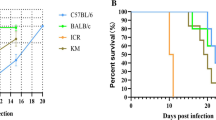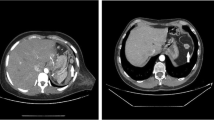Abstract
Autologous splenic fragments regenerate after transplantation. The regenerated mass only attains a small proportion of that of the normal spleen. Some data on the protective function are controversial. Malaria parasites were inoculated to test splenic function in rats. Peak parasitemia, the course of parasitemia, and anemia were comparable in normal and autotransplanted rats. In rats with splenic transplants only the duration of the parasitemia was longer than in normal rats. In contrast, splenectomized rats were unable to clear the parasites from the blood and became progressively anemic. After stimulating regeneration by increasing the work load to the white pulp or the macrophage system, more regenerated tissue was found, but the protective function did not increase. The amount of regenerated splenic tissue does not correlate with its protective function.
Similar content being viewed by others
References
Alwmark A, Bengmark S, Gullstrand P, Idvall I, Schalén C (1983) Splenic resection or heterotopic transplantation of splenic tissue as alternatives to splenectomy. Eur Surg Res 15: 217–222
Browder W, Rakinic J, McNamee R, Jones E, Williams D, Di Lucio N (1983) Protective effect of non-specific immuno-stimulation in postsplenectomy sepsis. J Surg Res 35: 474–479
Callow LL, Dalgliesh RJ (1982) Immunity and immunopathology in babesiosis. In: Cohen S, Warren KS (eds) Immunology of parasite infections. Blackwell, Oxford, pp 475–526
Chaikof EL, McCabe CJ (1985) Fatal overwhelming postsplenectomy infection. Am J Surg 149: 534–539
Chu DZJ, Nishioka K, El-Hagin T, Hopfer RL, Romsdahl MM (1985) Effect of tuftsin on postsplenectomy sepsis. Surgery 97: 701–706
Cooper MJ, Williamson RCN (1984) Splenectomy: indication, hazards and alternatives. Br J Surg 71: 173–180
Dürig M, Landmann RMA, Harder F (1984) Lymphocyte subsets in human peripheral blood after splenectomy and autotransplantation of splenic tissue. J Lab Clin Med 104: 110–115
Garnham PCC (1970) The role of the spleen in protozoal infections with special reference to splenectomy. Acta Trop (Basel) 27: 1–14
Horton J, Ogden ME, Williams S, Coln D (1982) The importance of splenic blood flow in clearing pneumococcal organisms. Ann Surg 195: 172–176
Landmann RMA, Dürig M (1988) Blood leucocyte changes during physical stress: evidence for altered cell distribution in patients with an autologous splenic replant. (in press).
Lanng Nielsen J, Andersen HMK, Hansen KB, Saksø P, Kristensen ES, Sørensen FH (1983) Protective effect of implanted autologous splenic tissue in splenectomized rats exposed to i. v. Streptococcus pneumoniae. Scand J Haematol 30: 367–373
Malangoni MA, Dillon LD, Klamer TW, Condon RE (1984) Factors influencing the risk of early and late serious infection in adults after splenectomy for trauma. Surgery 96: 775–782
Oster CN, Koontz LC, Wyler DJ (1980) Malaria in asplenic mice: effects of splenectomy, congenital asplenia and splenic reconstitution on the course of infection. Am J Trop Med Hyg 29: 1138–1142
Pabst R, Kamran D (1986) Autotransplantation of splenic tissue. J Pediatr Surg 21: 120–124
Pabst R, Hafke R, Hillebrand J (1985) Enhanced regeneration of transplanted splenic tissue by increased work load to the splenic compartments. J Trauma 25: 326–328
Pabst R, Hafke R, Hillebrand J (1985) Enhanced regeneration of transplanted splenic tissue by increased work load. Adv Exp Med Biol 186: 565–569
Pabst R, Peter M, Westermann J (1985) Problems in autotransplantation of splenic fragments: small mass of regenerated tissue and low blood flow. IRCS Med Sci 13: 360–361
Patel J, Williams JS, Naim JO, Hinshaw JR (1982) Protection against pneumococcal sepsis in splenectomized rats by implantation of splenic tissue into an omental pouch. Surgery 91: 638–641
Pimpl W, Thalhammer J, Pattermann M (1987) Perfusion of autologous splenic grafts in correlation with specific immunological functions — an experimental study in pigs. Eur Surg Res 19: 53–61
Scher KS, Wroczynski AF, Scott-Conner C (1985) Intraperitoneal implants do not alter clearance of pneumococcal bacteremia. Am Surg 51: 269–271
Schwartz AD, Goldthorn JF, Windelstein JA, Swift AJ (1978) Lack of protective effect of autotransplanted splenic tissue to pneumococcal challenge. Blood 51: 475–478
Sekikawa T, Shatney CH (1983) Septic sequelae after splenectomy for trauma in adults. Am J Surg 145: 667–673
West KW, Grosfeld JL (1985) Postsplenectomy sepsis: historical background and current concepts. World J Surg 9: 477–483
Westermann J, Pabst R (1986) Autotransplantation of splenic fragments: lymphocyte subsets in blood, lymph nodes and splenic tissue. Clin Exp Immunol 64: 188–194
Witte MH, Witte CL, van Wyck DB, Farrell KJ (1983) Preservation of the spleen. Lymphology 16: 128–137
van Wyck DB, Witte MH, Witte CL, Thies AC (1980) Critical splenic mass for survival from experimental pneumococcemia. J Surg Res 28: 14–17
Wyler DJ (1983) Splenic functions in malaria. Lymphology 16: 121–127
Wyler DJ, Quinn TC, Chen LT (1981) Relationship of alterations in splenic clearance function and microcirculation to host defense in acute rodent malaria. J Clin Invest 67: 1400–1404
Author information
Authors and Affiliations
Additional information
Offprint requests to: R. Pabst
Rights and permissions
About this article
Cite this article
Pabst, R., Westermann, J., Hillebrand, J. et al. Protective effect of stimulated splenic transplants against rodent malaria — preliminary results. Pediatr Surg Int 3, 338–342 (1988). https://doi.org/10.1007/BF00189172
Accepted:
Issue Date:
DOI: https://doi.org/10.1007/BF00189172




